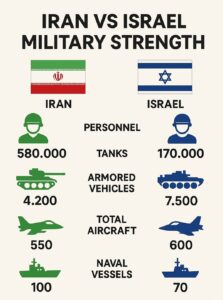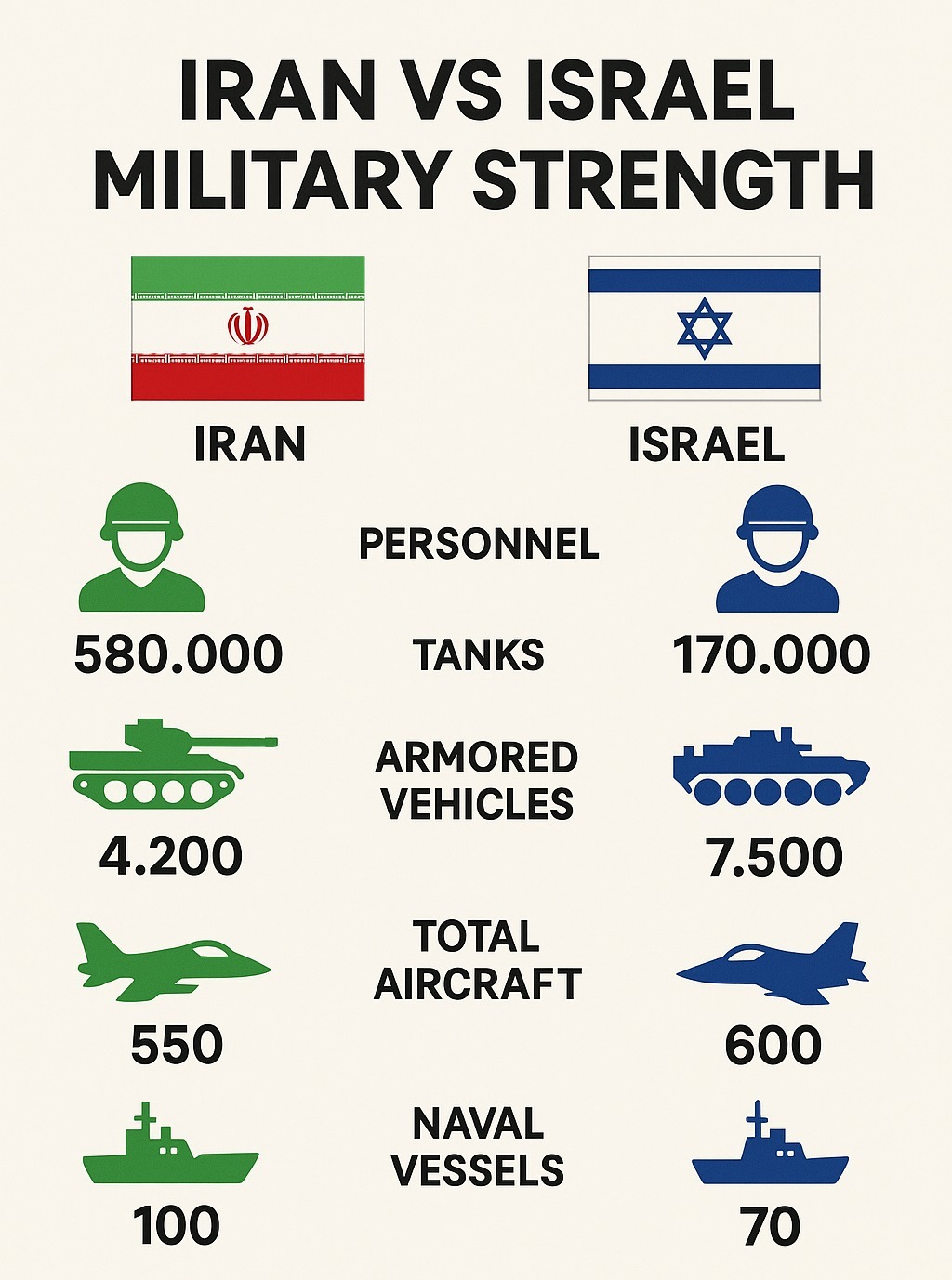
The Middle East is on edge. In mid‑June 2025, Israel launched a massive air campaign—dubbed Operation Rising Lion—against Iran’s nuclear and military infrastructure. In retaliation, Iran unleashed swarms of drones, hundreds of ballistic missiles, and continues to pursue nuclear power. But which side holds the advantage?
1. Air Power & Drone Warfare
Israel’s air strikes, carried out by stealth jets and armed drones, hit roughly 100 strategic targets including uranium-enrichment plants at Natanz and Fordow, missile bases, and the homes of top Iran Revolutionary Guard and nuclear scientists.
Iran’s drone toolkit includes the Mohajer‑10—a long-range UAV capable of penetrating deep into Israeli airspace with a 2,000 km reach.. It carries bombs and missiles and can hold position for over a day. Iran has also converted merchant ships into naval drone carriers to hit sea targets .
Israel’s Iron Dome and Arrow–3 systems are strong, but waves of drones paired with missiles could overwhelm common defenses.
2. Ballistic & Cruise Missile Exchange
Iran responded with MRBMs and SRBMs like Ghadr, Khorramshahr, Sejjil, and the new Qassem Bassir—a medium‐range missile unveiled in May 2025 with an impressive ~1,200 km range and enhanced stealth capabilities.
Iran reportedly launched more than 200 missiles in multiple salvos aimed at Israel’s major cities, including Tel Aviv . Israel claims many were intercepted, though some caused civilian casualties.
Israel struck back by destroying Iranian missile bases and targeting launchers inside Iran itself .
3. Nuclear Power & Deterrence
Both nations live under nuclear shadows:
- Israel is widely believed to be a de facto nuclear power, with an arsenal of up to 190 warheads and delivery means including aircraft, missiles, and submarines.
- Iran officially denies weapons ambitions but has enriched uranium to near weapons-grade levels, prompting strikes aimed at delaying its ability to build a nuke.
By striking hard now, Israel aims to delay Iran’s nuclear timetable—and send a message that escalation could lead to full‑scale war.
4. Command & Control Disruption
Israel also targeted senior commanders: General Hossein Salami, IRGC leadership, and top nuclear scientists were killed in the strikes. While Iran quickly appointed replacements, the goal was clear—to hamper Iran’s decision-making and response capabilities.
5. Who Has the Edge?
Let’s break it down:
✅ Israel’s Strengths
- Dominance in stealth jets, precision drones, and guided munitions.
- Advanced missile defense systems (Iron Dome, Arrow, David’s Sling).
- Nuclear deterrence via ambiguity and strategic depth.
⚠️ Iran’s Strengths
- Enormous missile arsenal (around 3,000+ missiles).
- Long-range drones capable of striking deep targets .
- Ability to coordinate with regional allies and proxies.
6. Risks of Escalation
Experts warn this could spiral into a “regionwide war” or global energy shock, with oil prices spiking amid fears of instability in the Strait of Hormuz.
Iran has threatened to target Gulf infrastructure or halt shipping lanes. Israel has vowed to respond with full force against civilian missile attacks .
7. Diplomacy & Global Stakes
The U.S. intercepts Iranian missiles while avoiding direct strikes, supporting Israel’s defense but pushing for restraint . Nuclear negotiations in Oman aimed to reduce Iran’s nuclear ambition—but Israel’s pre-emptive strike may undermine those efforts.
European and UN leaders are rallying to de-escalate, emphasizing dialogue over destruction .
Conclusion: Who’s Winning?
There’s no clear “winner” yet. Israel’s initial air campaign severely degraded Iran’s critical infrastructure, infrastructure, missile bases, and command hierarchy. In turn, Iran launched a vast missile and drone retaliation.
Both sides are testing each other’s air defenses and resolve. Israel holds technological superiority and nuclear deterrence, while Iran brings sheer quantity, range, and regional proxies. If this continues beyond tit-for-tat strikes, the outcome may depend on international intervention, economic pressures, and internal resilience.
For now, Israel has gained the tactical upper hand—but Iran’s arsenal means the war of attrition could be long and unpredictable. A global turning point may emerge if either side crosses red lines, such as civilian casualties or international shipping disruptions.











